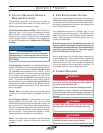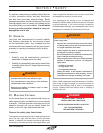
342 Performance
®
1.2
Section 1 • Safety
2. leGallY ManDaTeD MiniMuM
requireD equipMenT
The following equipment is the minimum required by
the U.S. Coast Guard for a boat 26' to less than 40' [7.9
meters to less than 12 meters] in length.
Personal Flotation Devices (PFDs): One Coast Guard
approved Type I, II or III device is mandatory for each
person aboard. One throwable Type IV device is also
required to be on board. A Type V device is acceptable
if worn for approved use. See Page 1.4 for a description
of these PFD classications. Always wear a PFD when
boating.
Fire Extinguisher - Portable: If no xed re extinguishing
system is installed in the engine and generator spaces,
the U.S. Coast Guard requires two (2) Type B1 or one
(1) Type B2 re extinguishers be on board. If your
boat is equipped with a xed re extinguishing system
in the engine and generator spaces, the U.S. Coast
Guard requires one (1) Type B1 re extinguisher be on
board. The American Boat and Yacht Council (ABYC)
recommends that you have three (3) Type B1 ABC re
extinguishers on board located in the following areas:
outside the engine compartment, at the helm station,
and in the galley.
Whistle, Horn: You must have on board some means
of making a loud sound signal, for example, whistle or
horn.
Visual Distress Signals: If you operate your boat in
coastal waters or on the Great Lakes, you must have
visual distress signals for day and night use on board. At
least three (3) U.S. Coast Guard approved pyrotechnic
devices, marked with date showing service life, must be
carried, be readily accessible, in serviceable condition,
and not expired. Store pyrotechnic signals in a well-
marked waterproof container in a dry location.
Other: Your Baja boat is equipped with the required
navigation lights, engine exhaust and ventilation
systems.
3. fire exTinGuishinG sYsTeM
Your boat may be equipped with the optional automatic re
extinguisher system, located in the engine compartment.
In the event of a re, the heat sensitive automatic head in
the engine compartment will release a re-extinguishing
vapor, totally ooding the area.
The dashboard contains an indicator light for the
automatic re extinguishing system. The light will be ON
when the ignition is on and indicates that the system is
ready. If the light goes out while the ignition is on, the
system has discharged.
When discharge occurs, immediately shut down all
engines, powered ventilation, electrical systems, and
extinguish all smoking materials. Do not immediately
open the engine compartment! This feeds oxygen
to the re and the re could restart.
Wait at least fteen (15) minutes before opening the
engine compartment. This permits the re-extinguishing
vapor to "soak" the compartment long enough for hot
metals and fuels to cool. Have portable extinguishers
at hand and ready to use in case the re re-ignites. Do
not breathe fumes or vapors caused by the re.
4. carbon MonoxiDe
In rainy and/or cold weather, fresh air must circulate
through boat to avoid carbon monoxide poisoning.
! DANGER
! DANGER
Sleeping on boat requires an operating Carbon Monoxide
detection system in each sleeping location.
Fumes from engines, generators, and other equipment
and appliances using burning fuel contain odorless,
colorless carbon monoxide gas.
Carbon monoxide can cause brain damage or death.
Open all doors, curtains, windows, and hatches to let
fresh air circulate, when running engine, generator or
burning any fuel when boat is anchored, moored or
docked.
DANGER
!
PFD REQUIREMENTS DIFFER
Depending on the state or country of operation
the operator of a vessel may be ned for failure
to comply with local or national rules regarding
PFD usage.
NOTICE


















